Sepphoris
The full name, "Galilee (circle) of the peoples" (Isaiah 8:23/9:1) may refer to the outer "circle" of cities, which sometimes exerted power themselves but more often represented this or that empire. From their positions on the edge of the circle, the cities sought to control the heart of Galilee. Yet that could be difficult: when taxes rose, the farmers could take refuge in the mountains, especially those of Upper Galilee (reaching 4000 feet). From here they sometimes attempted rebellion. In the First Testament period, the heartland did contain one exception, a fairly large city called Hannaton, which dominated the Beit Netofa Valley. In the Second Testament period, Sepphoris arose to become the exception, ruling the valley from a hill southeast of Hannaton.

Despite scant finds of a settlement at Sepphoris from the 8th century BC, there is no tellThe "Tell" In general, before the Roman period, a city needed a hill for defense, with a spring nearby. Certain proportions had to be right: the hill had to be small enough so that the population supplied by the spring would suffice to produce enough soldiers to defend a wall surrounding the hill. You needed enough good agricultural land to feed that population. (You also needed peasants in nearby villages to work the land – about ten for every aristocrat in the city.) If you wanted to engage in commerce, you had to be near a decent road. Only certain hills fulfilled these requirements, and therefore people kept building on them. That is why we find layer after layer on some few hills, called tells, while others remained unsettled., for the nearest spring is more than a mile away. The first real development took place around 100 BC, after the HasmoneansThe Hasmoneans: family of Judah Maccabee ("the hammer") and his brothers, who revolted successfully against the Greek Empire in 167 BC. They purified and re-dedicated the Temple in Jerusalem, establishing the festival of Hanukah ("dedication"). They ruled till 63 BC, and their domain extended almost as far as King David's. had conquered Galilee. They probably chose this hill because of its "bird's eye view" of the Beit Netofa Valley, through which the international trunk road ran. (See map below.) The Greek name Sepphoris transliterates the Hebrew Tzippori, derived perhaps from tzippor, meaning "bird."
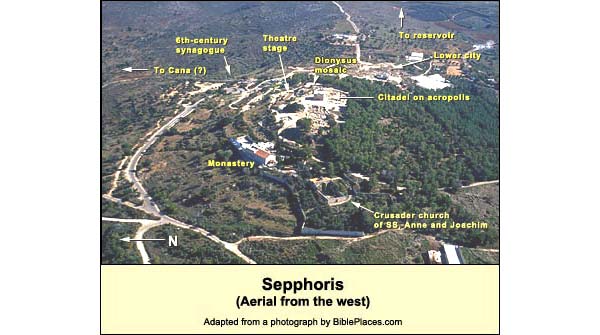
During Herod'sHerod ruled the land under Roman auspices from 37 - 4 BC. After his death, the Romans called him "the Great" because of his building activities. Christians chiefly remember him, however, as the killer of the innocent children (Mt. 2: 16). fight for power between 40 and 37 BC, he conquered the Hasmonean stronghold (in a blizzard, writes JosephusJosephus Flavius (36 – 100 AD), Jewish general, one of two directing the revolt against Rome in Galilee. After Vespasian captured him, he prophesied the latter would be emperor. When this proved true, the Romans honored him. He then turned historian, writing The Jewish War, The Antiquities of the Jews and many other books. Because of a paragraph about John the Baptist (and maybe a sentence about Jesus), the Church preserved his works.). He used it, no doubt, as a base for taxation, which he carried out so assiduously that the nearby peasants rose in revolt when he died in 4 BC. Defeated, they were sold by the Romans into slavery. (Archaeology shows no trace of battle in the city itself.) Herod's realm was then divided among his three surviving sons. Among them was Herod Antipas, who became Tetrarch of Galilee (and of Perea across the Jordan). Lacking any of the large peripheral cities, he decided to build up Sepphoris as his capital.
That explains why we find this exceptional phenomenon, a city in the Galilean heartland, during the Second Testament period. Sepphoris was still confined to the hill; for water it relied on cisterns. But it must have been an expensive undertaking, built with the taxes of Galilee's peasants and fishermen. Among the workmen we may picture Joseph and his teenage son, who could have commuted from their village, four miles south. Here Jesus may have met a young worker from Cana, probably to be identified with a ruin that is today called Khirbet Kana, five miles to the north.
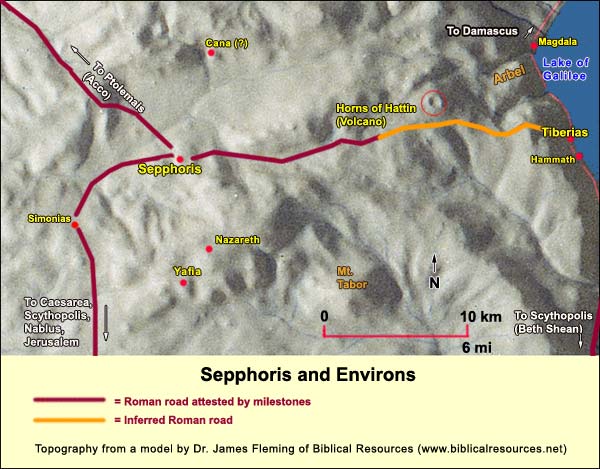
{mospagebreak title=In 1st Jewish revolt}
The Jewish revolt against Rome, as seen from Sepphoris
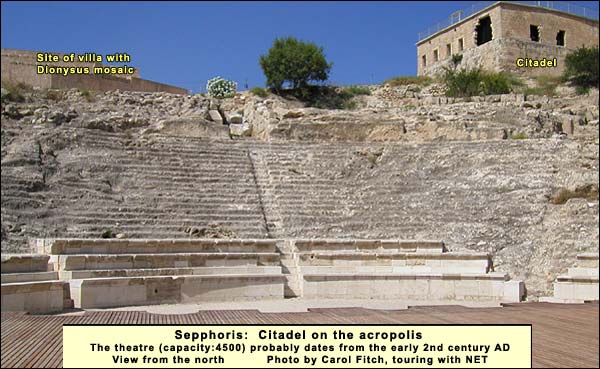
To the west is the hulk of upper Mt. Carmel. To the south and east is modern Nazareth (the ancient village lies just beyond and below the line of the ridge). Due east are the villages from whose springs came the aqueducts that supplied Sepphoris in the Roman period. Five miles to the north is Khirbet Kana ("the ruin of Cana"), perhaps the village of the wedding feast (John 2:1-11).
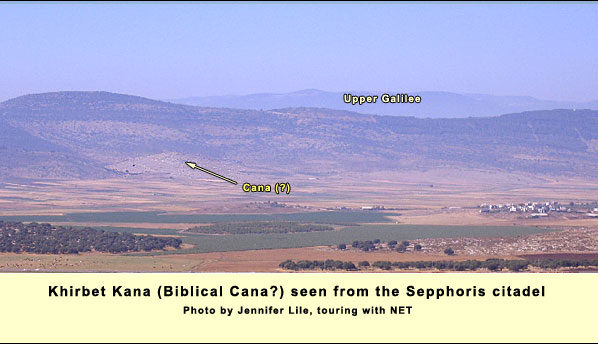
In the farther distance are the mountains of Upper Galilee, reaching 4000 feet above sea level. On days of good visibility one can make out a piece of Mt. Hermon. Our special reason for standing here, however, is to bring alive an event from the Jewish revolt against Rome. Elsewhere we cover the causes of this revolt, which began in 66 AD. The Romans, for a long time, failed to recognize the seriousness of the problem. Ever since the decrees of Julius CaesarThe Decrees of Julius Caesar Favoring the Jews,Josephus, Antiquities of the Jews XIV 10.1-8 (Whiston translation), they had allowed the Jews a kind of favored-nation status, and so, in their view, they were carrying on a relatively benevolent, enlightened occupation. Why then should the Jews revolt? The Romans did not even keep a legion in the land. They sent mere equestrians as governors. That is, they completely overlooked a vital factor that would press the Jews to revolt: the covenant faith. (Explanation.) When at last the Romans realized that a full-fledged revolt was underway, they sent legions under their best general, Vespasian, who came fresh from defeating the Germans. He was joined by his son Titus. These landed in Ptolemais (Acco). The Jewish gentry of Sepphoris, wanting no part in a revolt whose disastrous outcome they foresaw, sent representatives to Ptolemais and quickly made peace. The Galilean peasants, however, had a long tradition of revolt against Empire. They had the mountains as a refuge. They had a report of the first rebel victories in Judaea. They had their belief that this was the time of the messianic birth pangs, and so they could interpret those early victories as the beginning of redemption. The future historian JosephusJosephus Flavius (36 – 100 AD), Jewish general, one of two directing the revolt against Rome in Galilee. After Vespasian captured him, he prophesied the latter would be emperor. When this proved true, the Romans honored him. He then turned historian, writing The Jewish War, The Antiquities of the Jews and many other books. Because of a paragraph about John the Baptist (and maybe a sentence about Jesus), the Church preserved his works. was sent up from Jerusalem to lead some of them. In the Jewish War,War= Josephus Flavius. The Jewish War. Translated by William Whiston. (Abbreviated in text as War.) Josephus describes Vespasian's entry from Ptolemais into Galilee. Standing on the roof of the citadel and looking to the side of Tell Hannaton, we can picture the event. The story has a sequel. After they had reduced the other Galilean strongholds, the Romans concentrated on Josephus' last redoubt, Yotpata, whose hill is also visible from here. Despite Josephus' clever ruses (such as pouring olive oil on the Roman siege ramps), the enemy broke in. Josephus and other aristocrats took refuge in a cave beneath the city. The others wanted to kill themselves rather than fall alive into Roman hands. Josephus argued against such a move, but to no avail: they would kill one another in order, as determined by lot. Josephus managed to pick a good lot for himself, surviving and surrendering. Brought by the Romans before Vespasian. but why not go to the source? The prophecy that Josephus mentions is a variant of the messianic prophecy, which had contributed to the birth of Christianity, had fueled this revolt. and would fuel yet another, that of Bar Kokhba, in 132 AD. {mospagebreak title=Jewish and Gentile} Sepphoris as a mixed city, Jewish and Gentile Because Sepphoris did not join the revolt against Rome in 66, it survived unharmed, as did Tiberias (founded by Herod Antipas between 17 and 21 AD), which had quickly surrendered. Jerusalem was of course another story. The Romans had destroyed both the Temple and the city in 70. It was questionable whether Judaism could survive without the Temple. Under Rabbi Yohanan Ben Zakkai, however, an academy was established at Yavneh, south of Jaffa, for the preservation and elaboration of Jewish law. But what has that to do with Sepphoris? We shall follow a course of events that will lead this academy northward, and eventually to Sepphoris, where in 200 AD its most important work will be accomplished. Jews were dispersed throughout the known world, east and west, but they'd had a common focus in the Temple. It had been the authoritative source for the teachings and practice of Judaism. By sacrifices made there, one had been able to maintain one's relation with God in the manner He had ordained. This Temple was gone. Out of the ashes, however, Ben Zakkai and his disciples created a new form of Judaism. Since they could no longer perform the sacrifices, they recited in daily prayer how they used to perform them, and this, they let it be known, would suffice. They also elaborated the laws written in the Torah, creating, as they put it, "a fence around the law": by obeying the "new" laws (which they claimed were not new at all, but were given orally by God to Moses on Sinai), people would not come close to violating the written ones. It is written, for example, that one should not cook a young goat in its mother's milk (Exodus 23:19 and elsewhere), but the rabbis fenced this in by forbidding all mixing of meat and milk. The dietary laws became so elaborate that pious Jews could hardly accept an invitation to a Gentile's home for dinner. (Mutual dinner invitations, then as now, were an essential step in the development of friendship.) The effect of these and other laws was to keep Jews together, isolated from the Gentiles, despite their dispersion in various countries. In 132 AD, the Jews of Judea again revolted against Rome. The rebels considered their leader, nicknamed Bar Kokhba ("son of a star") to be the messiah. It took the Roman emperor Hadrian three years to quell the uprising, and at great cost to Roman life and treasure. As one of his punitive measures, he banned basic Jewish practices, such as circumcision, in Judaea. Pious Jews had to leave that area. Among them were the members of the rabbinical academy of Yavneh, which had constituted itself as the Sanhedrin.
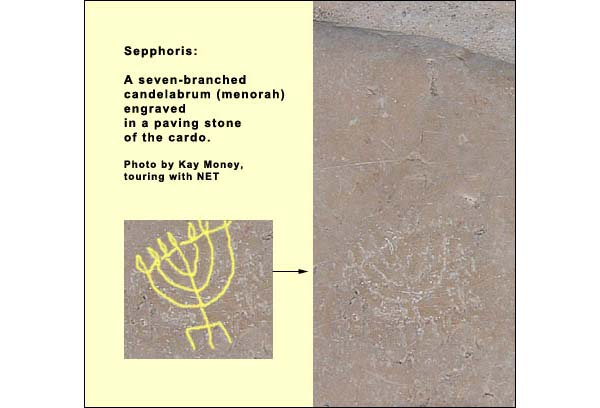
Here Galilee became relevant. Apparently, it had refused to follow Bar Kokhba, and therefore it escaped punishment. The Sanhedrin moved north, trying various Galilean towns. Most were still in ruins from the debacle of the first revolt. Sepphoris (renamed Diocaesarea in honor of Zeus and the emperor) stood unharmed, however, because of its peace treaty with Vespasian. Here the Sanhedrin settled around 200 AD. Here too the oral law, which had been developing through the years, was at last committed to writing in tractates known collectively as the Mishnah. (The deaths of so many teachers during the Bar Kokhba revolt may have motivated the writing down of the laws.) This book became the core, in turn, of the Talmud. On the basis of the laws contained in these works, which determined the practices of daily life, the Jews were able to retain their national identity for more than a thousand years without land. (See Word and Earth.) Sepphoris is important, then, as the site of this crucial historical event: the creation of the book that maintained the Jewish people through the centuries. The leader who ordered the writing was Judah ha-Nasi (Judah the Patriarch), a man of great influence, it would seem, not only over his fellow Jews but also with the Romans. Under him Sepphoris became a predominantly Jewish city. Jews resumed control of its council and issued coins. At Judah's death, he was eulogized in each of the city's 18 synagogues. Of these no trace has been found, except for scant inscriptions on mosaics that were re-used in the Crusader church of Saints Anne and Joachim, just west of the hill. Apart from coins and a few engravings of the seven-branched candelabrum from the long-defunct Temple in Jerusalem, the main signs of Jewish presence are the ritual baths, hewn into bedrock, throughout the city. The Jerusalem Talmud (written in Tiberias, actually) mentions rabbinical sermons that were delivered in the academies of Tzippori (Sepphoris). Below the acropolis and a bit to the north, archaeologists found a mosaic floor very similar, in its motifs, to those of the ancient synagogues at Beit Alpha and Hammath Tiberias. The artist depicted events from the biblical accounts of Abraham, a zodiac, scenes from the Temple ritual, and the Holy Ark girded by seven-branched candelabra. It is dated to the 6th century AD.
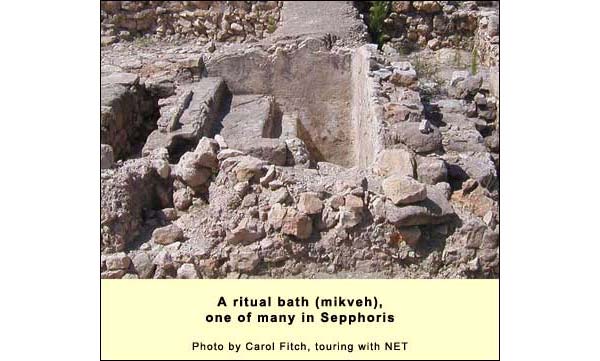
{mospagebreak title=Dionysus} Dionysus at Sepphoris On the acropolis, just east of the citadel and above the theatre, was a large residence, built around 200 AD (when the Mishnah was being written in Sepphoris) and destroyed in the major earthquake of 363. The rubble covered the floor of its dining room. This was in the form of a triclinium, typical for the Roman aristocracy: diners lay on couches, set up in the shape of a U. When the archaeologists scraped the dirt from the floor, they discovered what the diners contemplated as they ate and drank: a remarkable mosaic depicting scenes from the life of Dionysus. Those who lay on the middle couch had before them the exquisite portrait of a lady. She was cast in the role of Venus with a Cupid on her right shoulder.
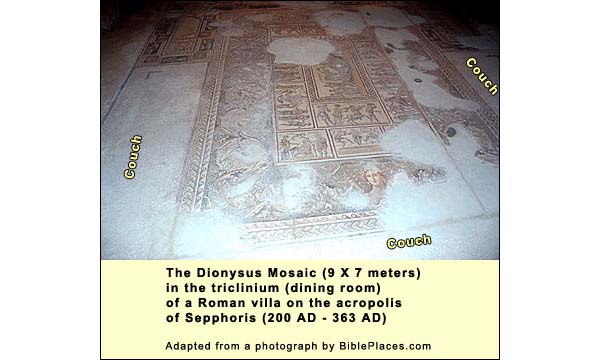
The colors in a mosaic are those of the actual stones (cut into semi-cubes called tesserae). This one features 23 shades. When the artist reached the lady, he chose smaller tesserae, enabling him to bring such nuance to her cheeks and glance that she appears to come alive. To the young girl who scraped the dirt away in 1982, it must have seemed like a resurrection. The effect is heightened by contrast with the surrounding mosaic, done in a rougher style.
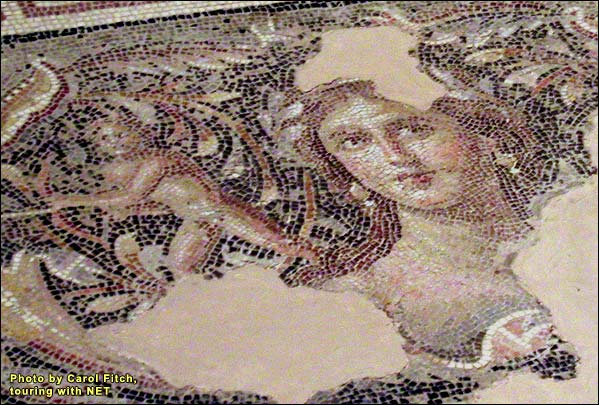
Fifteen panels celebrate Dionysus (Bacchus), perhaps the only Greco-Roman god who is still much worshiped today. After a lengthy disappearance, he re-emerged in 1956 on the Ed Sullivan Show in the person of Elvis Presley. For Dionysus is not just the "god of wine," but the god of frenzy, the god of letting go, a god who brings to the surface subterranean urges that threaten to break up the social order. The greatest expression of this aspect is the Bacchae by Euripides (a recent edition of which features Elvis on the cover). The main phenomena of Dionysus' cult can be found in the modern rock concert, where the devotees (Maenads) are "fans," and where the long-haired star incarnates this god whose tresses were vines.
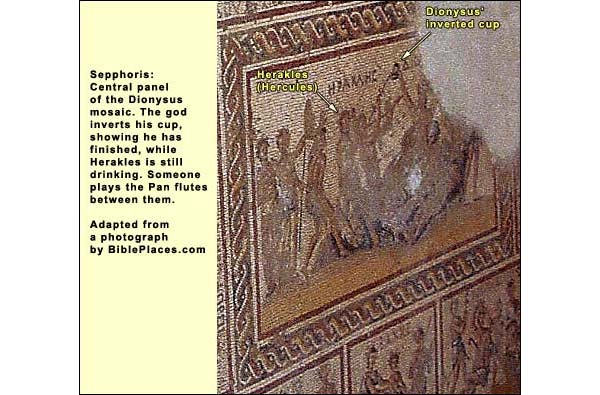
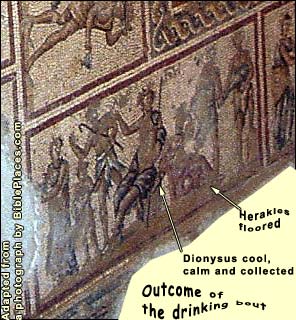
The central panel in the Sepphoris mosaic (above) shows Dionysus in the midst of a drinking bout with Heracles (Hercules), while the flutes of his cousin Pan are played between them. In a panel northwest of this (right) we see the outcome: Heracles is on the floor, while Dionysus, inverting the cup to show he has drunk it all, retains control. There we have the principle of Dionysus. His rivals and his devotees may fall on their faces, but the god himself never loses control. He is the epitome of abandon and control, such that one can say: the more wildness, the more form. It is the paradox of all great art, of which this god is patron. A "Homeric Hymn" to Dionysus shows that he could transform things to wine by a touch. And now, thanks to recent archaeological discoveries, we can see how strong his worship was in Galilee, famous for its many wines. Not only do we have this mosaic floor, but we find him in grand style at Scythopolis: he was the patron of that mighty city. When Jesus was growing up, Dionysus must have been a powerful presence throughout the area. That would have been the context for the first of the signs in the Gospel of John (John 2:1-11). Jesus and his mother attend a wedding at Cana, probably Khirbet Kana just across the valley from Sepphoris (perhaps he had met the future bridegroom while both were workmen here). There Jesus does the "Dionysus-thing," out-Dionysusing Dionysus in Dionysus-land.

The story of Dionysus' birth expresses his character. His father was Zeus. The mother, however, was not Hera, Zeus' wife, but Semele, a mortal. Disguised as an old woman, Hera wheedled the pregnant Semele into wheedling Zeus to show himself in his true form. This was of course the lightning stroke, which turned Semele to a crisp. Zeus saved the embryo and sewed it into his thigh, out of which, at term, burst the god of flowing wine. In an alternate version, the mother was Persephone, who finished her nine months. Jealous Hera set the Titans against the infant. They hacked him to pieces, devouring all but the heart. Zeus rescued this, had Semele eat it, and out of her Dionysus was born a second time. Both versions contain the idea of death and rebirth. Dionysus was sometimes called the "twice-born" and the "insewn." There may be a connection to the practice of pruning the vines, as well as to the deep winter sleep that vines must undergo in order to produce good grapes. {mospagebreak title=Lower city} The lower city of Sepphoris, the Nile mosaic, and the aqueducts In the 2nd century AD, Sepphoris spread over a large area below the acropolis to the east. This part of the city is laid out in the Hippodamic pattern: the streets run either parallel or perpendicular to one another, forming regular squares or insulae. The north-south street was called the "cardo" ("hinge"), while the east-west street was the "decumanus." The pavement, of hard white limestone, was rutted in the course of time by cart wheels.
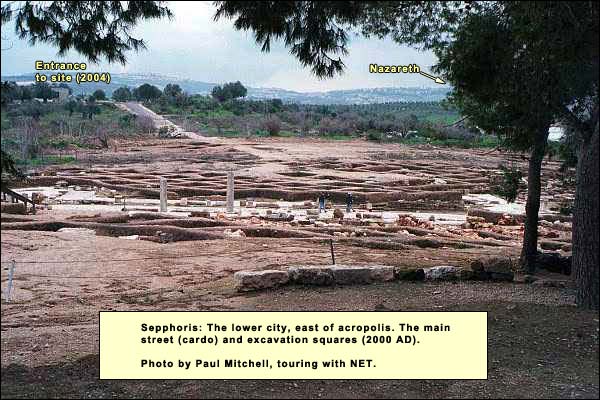
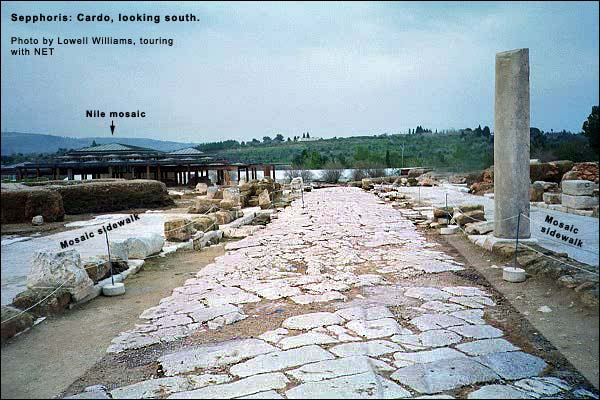
At one place on the street, someone carved the main Jewish symbol of antiquity: the seven-branched candelabrum. (The Star of David came much later.)

Heading south on the cardo, we find a large modern structure sheltering what must have been a big public building in the 5th century AD. It is full of well-preserved mosaic floors, whose designs range from abstract to figurative. One of these celebrates a year when the flooding of the Nile reached 17 cubits, about 25 feet. Why, one wonders, the Nile? No one knows, but this is not unique. The mosaic at the Church of the Multiplication in Tabgha is full of Nile scenes. Josephus mentions a belief that the Tabgha springs were an offshoot of the Nile, but there aren't any springs at Sepphoris. Perhaps the mosaic artist came with a catalogue of proposals, and the town council chose this. Yet the presence of special drainage channels in this room and the main hall lead the archaeologists to think that people may have conducted a festival here, pouring water on the floor. (A bathhouse was next door to the north.) The Nile could have been chosen for its fame as a water source. Or here is another alternative: a high flood level meant prosperity for Egypt, the effects of which might have been felt as far as Galilee.
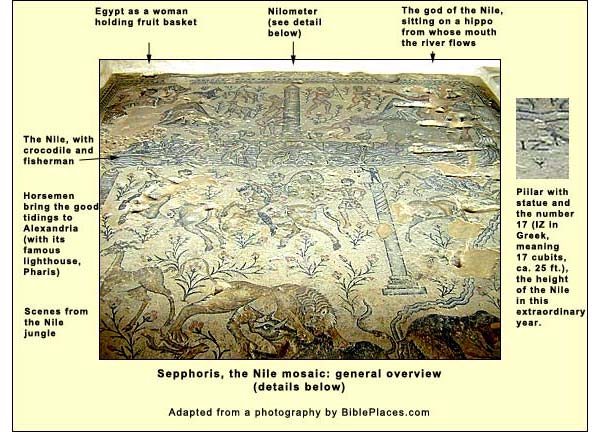
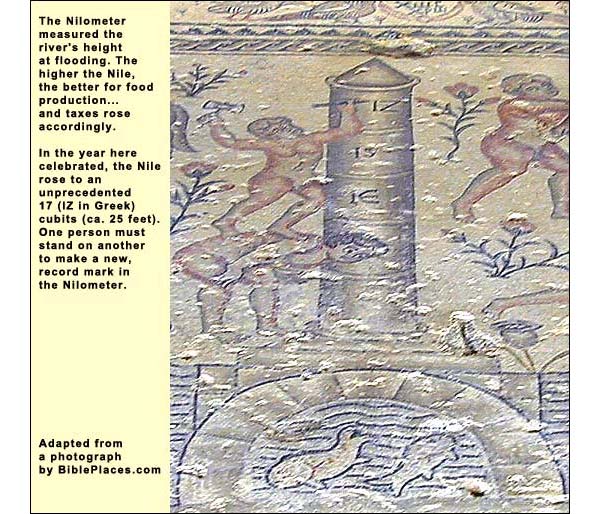
The enlargement of Sepphoris increased its water requirements, and Roman engineering provided an answer. Aqueducts were built to the lower city from two small springs on higher ground about 3.5 miles to the west. Less then a mile away, the engineers found a soft geological formation, out of which they dug a reservoir 200 meters long, enough for 10,000 cubic meters of water. From the fifth century, the Christian community grew. West of the cardo, across from the Nile house, are the remains of a basilica, one of several. Sepphoris lasted beyond the Byzantine periodThe Byzantine period – that is, the period of the Eastern Christian Roman Empire –may be dated from 330 AD, when Constantine re-named the city of Byzantium "Constantinople" and dedicated it to the God of the Christians. Its end, in this land, came in 638, when the Muslims took Jerusalem. Elsewhere it lasted much longer: Constantinople finally fell to the Turks in 1453. into the early Arab era, but then, for reasons that are still unknown, it declined until its rebirth as the Arab village of Saffuriya. {mospagebreak title=Logistics} Logistics Telephone (054-656-8272) Nature Reserves and National Parks (Main office: 02/500-5444) Opening hours: April 1 through September 30, from 8.00 - 17.00. (Entrance until 16.00)* October 1 through March 31, from 8.00 - 16.00. (Entrance until 15.00)* *On Fridays and the eves of Jewish holidays, the sites close one hour earlier. For example, on a Friday in March one must enter by 14.00 and leave by 15.00. One should arrive at least two hours before closing time in order to see the essentials.